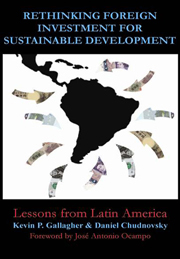Book contents
- Frontmatter
- Contents
- List of Figures
- List of Tables
- Foreword
- Acknowledgements
- Author Biographies
- Rethinking Foreign Investment for Sustainable Development
- 1 FDI and Sustainable Development in the Americas
- 2 Is Foreign Investment Always Good for Development?
- Part 1 Country Assessments
- 3 Islands of Possibility: MNCs and Economic Development in Brazil
- 4 Foreign Investment: The Polarization of the Mexican Economy
- 5 A Missed Opportunity: Foreign Investment and Sustainable Development in Argentina
- 6 Foreign Investment and Economic Development in Costa Rica: The Unrealized Potential
- Part 2 Political Economy of Natural Resources and The Environment
- Notes
- References
- Index
5 - A Missed Opportunity: Foreign Investment and Sustainable Development in Argentina
from Part 1 - Country Assessments
Published online by Cambridge University Press: 05 March 2012
- Frontmatter
- Contents
- List of Figures
- List of Tables
- Foreword
- Acknowledgements
- Author Biographies
- Rethinking Foreign Investment for Sustainable Development
- 1 FDI and Sustainable Development in the Americas
- 2 Is Foreign Investment Always Good for Development?
- Part 1 Country Assessments
- 3 Islands of Possibility: MNCs and Economic Development in Brazil
- 4 Foreign Investment: The Polarization of the Mexican Economy
- 5 A Missed Opportunity: Foreign Investment and Sustainable Development in Argentina
- 6 Foreign Investment and Economic Development in Costa Rica: The Unrealized Potential
- Part 2 Political Economy of Natural Resources and The Environment
- Notes
- References
- Index
Summary
FDI has played a major role in Argentina's economic transformation. During the 1990s, a period of deep structural reforms largely based on the neoliberal “Washington Consensus,” Argentina was one of the main destinations for FDI among “emerging markets.” MNCs were already a major presence in the Argentine economy. With the surge in FDI during this period, the role of MNCs reached unprecedented levels. In 2003 more than 80 percent of the value-added generated by the 500 leading Argentine firms belonged to MNC affiliates.
In the view of the reformers, FDI was to play a significant role in the needed restructuring of Argentina's economy. At the macroeconomic level, FDI was to help finance current-account deficits. Since MNCs often follow long-term investment strategies and, once installed in a host country, have large sunk costs, the reformers believed FDI would be less volatile than portfolio investment and other types of international financial flows. Last but not least, FDI was supposed to contribute to investment, and therefore to economic growth and increased employment, not only directly, but also indirectly; that is, by fostering investments by local firms competing with, serving as suppliers to, or making purchases from MNCs (so-called “crowding in” effects discussed by Agosin in the Chapter Two).
At the microeconomic level, foreign firms engaging in FDI usually have ownership advantages (Dunning 1993) over local firms in the host markets where they invest.
- Type
- Chapter
- Information
- Rethinking Foreign Investment for Sustainable DevelopmentLessons from Latin America, pp. 77 - 96Publisher: Anthem PressPrint publication year: 2009
- 2
- Cited by



